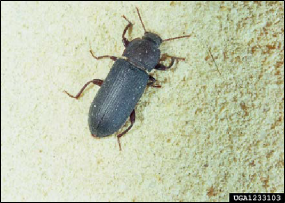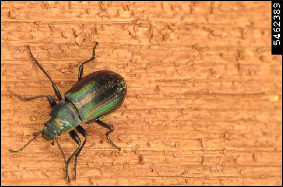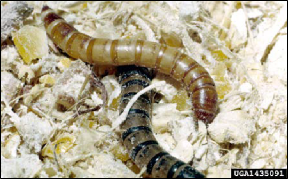Darkling Beetles and Mealworms
ID
ENTO-283NP (ENTO-548NP)
Introduction
Darkling beetles belong in the beetle family Tenebrionidae (Order Coleoptera), which includes more than 20,000 species. “Mealworm” is a general term used to refer to the larvae of darkling beetles, particularly those species that are pests of grains and other stored products.
Description
Adult darkling beetles widely range in shape and size, with most measuring from 2-19 mm (0.13-0.75”). Adults range in color from tan to reddish brown to brownish black and can be shiny or dull (Fig. 1). The elytra (the wing covers) can be smooth, grooved, or otherwise sculptured. A few species have colorful patterns on their wing covers (Fig. 2), but most do not. Adults are most active at night and tend to avoid bright lights.

Darkling beetle larvae are often referred to as mealworms or false wireworms. They are long, hard-bodied grubs with a cylindrical or somewhat flattened shape and are usually a shade of brown (Fig. 3). They are active crawlers and usually burrow through the substrate where they develop.


Habitat
Outdoors darkling beetles are often found under bark, in fungi, under rocks and decaying wood, or in leaf litter. Most species feed on plant materials, dead insects, and fungi. Some species are stored product pests found in dried grains or grain products, and places where these products are milled and stored.
Life History
Darkling beetles have a complete life cycle with egg, larval, pupal, and adult stages. Most species of darkling beetles have a slow rate of development and may live for a year as an adult. Species living on grains or other stored products may develop faster.
Damage
Darkling beetles can be pests of stored products in the home, barns, processing plants, or other places where dried foods are kept. Species such as the confused flour beetle (Tribolium confusum) and the red flour beetle (T. castaneum) feed on dried corn, rice, beans, cereals, and similar grain-based foods, including crackers, pasta, flour, and dry pet food. They are too small to damage intact grains but readily feed on cracked, broken, or milled grains. They also feed on birdseed, garden seeds, and ornamental corn or wheat. Darkling beetles are often found in dried foods that have been improperly stored and have become damp and moldy. Some species produce compounds that taint food with a bad smell and taste. Darkling beetles prefer to hide from the light, so populations may build unnoticed over time until they reach large numbers.
The lesser mealworm (Alphitobius diaperinus), also known as the litter beetle, is a pest of poultry houses. This beetle consumes chicken feed and negatively impacts the health of the birds, particularly in commercial poultry houses. Migrating larvae damage the physical structure of chicken houses when they chew through wood and insulation as they seek pupation sites.
Control
Stored product pests are best controlled through inspection and proper storage of susceptible food items. Regularly check stored products for signs of infestation such as the presence of cast skins and insect parts, or any signs of feeding activity such as powdery, dusty material or hollowed out grains. Remove and discard any products that show signs of infestation. Foods can be heat-treated or placed in a freezer for several days to kill any living insects. Clean and vacuum shelves and the insides of cabinets. Replace shelf paper if used. Place foods in sturdy sealed containers to prevent beetles from getting into the food, or to limit the spread of an infestation from infested food brought into the house.
Darkling beetles may enter homes while exploring their environment. Keeping a home in good repair can greatly limit the entry of insects into the home. Check and seal any gaps found around windows and doors, in foundation walls, or places where pipes enter a building. Make sure window screens fit tightly and are in good condition. The occasional darkling beetle inside the home can be controlled with the use of a fly swatter, a vacuum, or an aerosol insecticide. Follow all pesticide labels carefully.
Spilled animal feed and hay attracts darkling beetles in barns and animal housing. Clean up and dispose of spills as they occur.
Important Species
The larvae of the dark mealworm (Tenebrio obscurus) and yellow mealworm (T. molitor) are commonly found in damp grain. The adults are very similar in appearance, approximately 14 mm long (0.6”) and dark brownish black. Adult dark mealworms have a dull luster while adult yellow mealworms are somewhat shinier. The common names refer to the lighter color of the yellow mealworm larvae compared to the dark mealworm larvae.
Mealworms are commonly raised to feed reptiles, amphibians, and birds kept as pets or in zoos. The large larvae of Zophobas morio, sometimes called “superworms,” are popular as animal feed. This species can successfully complete its life cycle on polystyrene and polyethylene plastics thanks to its gut microbes, which may prove useful in reducing the accumulation of some types of plastic waste (Rumbos & Athanassiou 2021).
References
C.I. Rumbos, C.G. Athanassiou. 2021. The Superworm, Zophobas morio (Coleoptera: Tenebrionidae): A ‘Sleeping Giant’ in Nutrient Sources, Journal of Insect Science 21(2), https://doi.org/10.1093/jisesa/ieab014
Revised
Theresa A. Dellinger, February 17, 2023.
Virginia Cooperative Extension materials are available for public use, reprint, or citation without further permission, provided the use includes credit to the author and to Virginia Cooperative Extension, Virginia Tech, and Virginia State University.
Virginia Cooperative Extension is a partnership of Virginia Tech, Virginia State University, the U.S. Department of Agriculture (USDA), and local governments, and is an equal opportunity employer. For the full non-discrimination statement, please visit ext.vt.edu/accessibility.
Publication Date
March 3, 2023



